
From MashupDad
Rachel has been on me to write a recap of and follow-up on the great backyard chickens experiment of 2014. I'm not much of a writer, but here goes!
I'm a beekeeper, and as such, you attract a certain amount of anxious attention from your neighbors. One of our neighbors approached me and asked if he could visit the hives with me sometime and if I'd want to trade some honey for some eggs. I came to find out that he was keeping chickens, which immediately fascinated me. So, I went over to his house to see them -- and tucked in at the side of his house he had a kids' playhouse that he'd converted into a coop with a large fenced in area for them to roam. He gave me a few eggs, and they were amazing!
I started to do a bit of reading and research and found out it takes almost nothing to provide chickens what they need to start producing eggs. And, I quickly found out that you could spend either a lot of money, or very little; it all depends on your level of frugality and spirit of adventure. Since I'm married to Mashup Mom, frugality is a requirement -- but the spirit of adventure comes in, in that I really didn't know what I was doing when it comes to power tools and haven't progressed much since middle school shop class. I'm definitely not a woodworker. Luckily, though, we have an old detached garage that would hide from most of the world how inept I am with carpentry.
The Challenge
We decided it would be worth a try to see if I could build a coop. My goal was to see if I could do it with the spare lumber I had lying around and less than $150 of cash.
Initial construction
I needed to buy a few 2x4s, some chicken wire, a sheet of the cheapest plywood I could find, and a bunch of wood screws (so I could take apart the monstrosity or easily fix it. Home Depot will cut plywood into manageable sizes for you. (If you make the mistake of telling them about your project, you will get endless advice and stories from the guys there on similar projects they or their friends or family have made!) Actually, I've found Home Depot folks to be extremely helpful. Like I said, I have no idea what I'm doing, and almost everyone I talk to there is a seasoned pro.
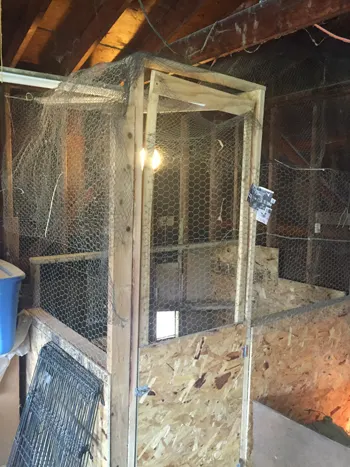
So, I had two pieces of 2x4 (9 ft and 6 ft) which became the outside perimeter of the coop. I built it against the back corner of the old detached garage so that the next two walls were already done, and started building up from there. The rule of thumb is that you need four square feet of space per bird if they don't have easy access to a chicken run. My plan, though, was to give them lots of space and a big run to scratch and peck in. I framed the walls and filled in the bottoms with spare plywood, then I used chicken wire to complete the walls.
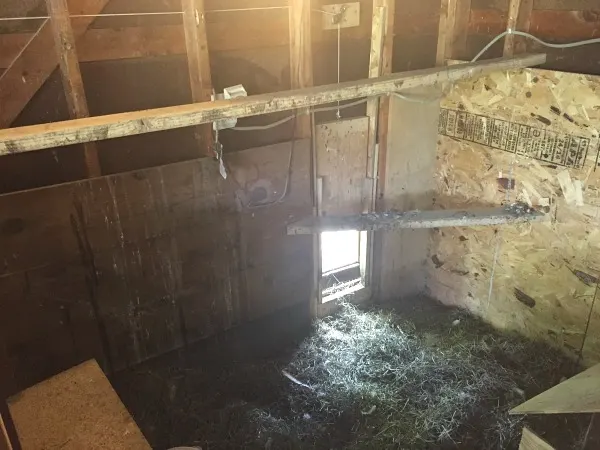
I built a roost from a 2x4 about 5 feet off the ground, using the rule that a chicken will roost at the highest point possible. I also added a two-hen nesting box, but found out later that they all like to share the same nesting compartment and take turns laying.
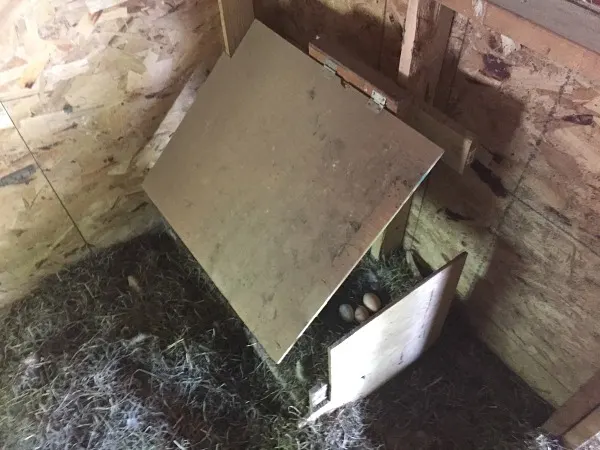
The nesting boxes are opposite the roost. (You don't want to have anything under the roost, because chickens poop all night long.) The area under the roost is a mess... always.
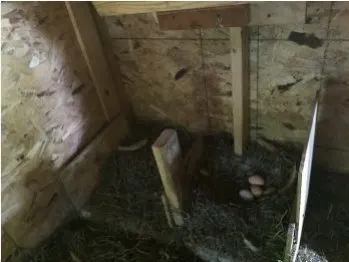
Later I also had to add poultry netting above the coop. The chickens were up on their roost (about 5 feet up) and noticed the fluorescent lights above them, so then decided it would be much better to roost up there (about 10 feet up). After a lot of swearing and breaking of fluorescent tubes, I managed to get them all down, then covered over the coop.
My biggest single expense here was renting a Sawzall from Home Depot. It's amazing that when you tell this story how many people you know turn out to own Sawzalls and tell you: "The next time you need one just come borrow mine." I'm a digital marketer by trade and will never, ever need a Sawzall again -- but thanks, y'all.
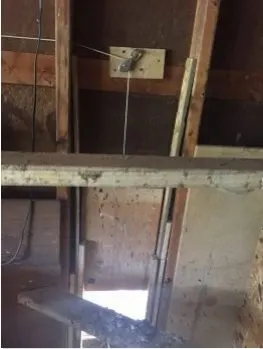
The last piece inside was to rig up a chicken door to the outside so I can let them out in the morning and close them in at night. I ran a pulley here so we can open and close the chicken door from right inside the door to the garage without going into the coop. We live in an area with raccoons, skunks, coyotes, neighborhood cats, and curious children, so the door was a necessity -- and a huge amount of fun to figure out.
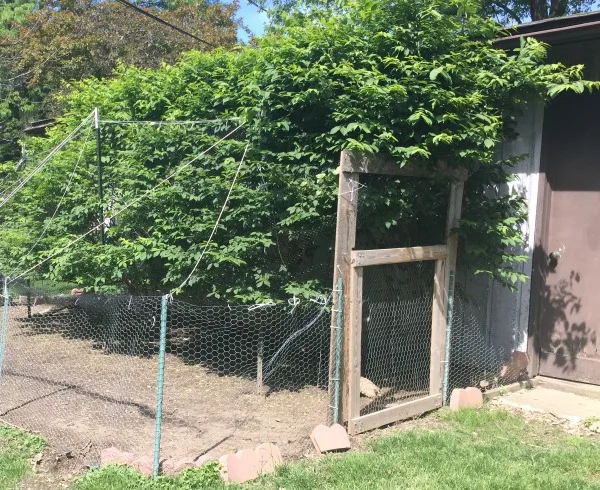
We started our backyard chickens experiment with three baby chicks, and once the chickens were big enough (a few months) I decided it was time to give them access to the outside. Around the side of the garage I added a chicken wire fence and covered it with poultry netting. The poultry netting wasn't really to keep the birds in, but to keep hawks out (add that to the above list of neighborhood predators!).
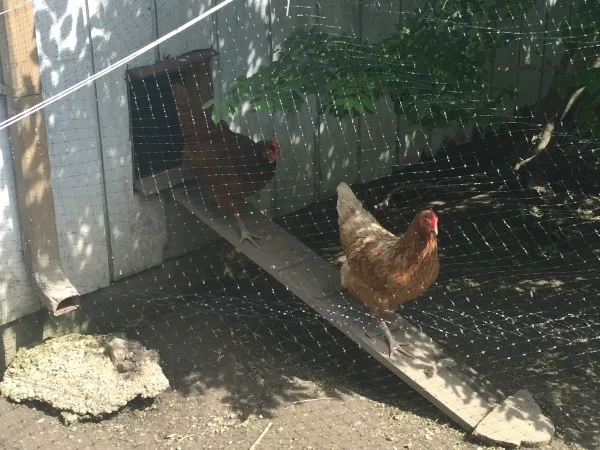
I also made a ramp for the chickens to get down from the coop into the yard. Notice that in the run, it didn't take long for the chickens to eat every single blade of grass and a bunch of the lower leaves off the bushes.
Picking up chicks
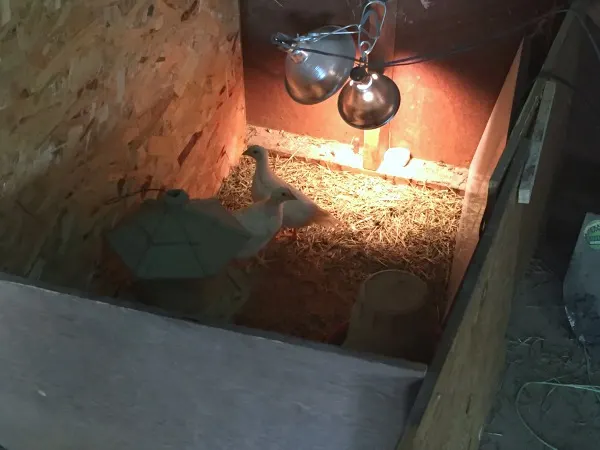
So that's the building process, and then I was ready for business. I bought our first chicks in July of 2014. Baby chicks are really adorable for the first two or three weeks, then they grow feathers and start pooping in EVERYTHING. They make all kinds of gadgets and whatnot for chick rearing, but I just used two 75 watt light bulbs and an old radiant wall heater I had to help keep the chicks warm. Baby chicks need to be kept warm but if you give them a heat source once they are a little bigger, they seem to regulate their own temperature. While they were small I kept them in a smaller enclosed area, since they were too little for the bigger coop. I did buy a chick waterer, and as a feeder I used a regular bird feeder (a 3 lb feeder from Walmart). A chick feeder can run you $30 bucks and needs to be refilled all the time, but I think the bird feeder was around $10 and I needed to fill it every two weeks.
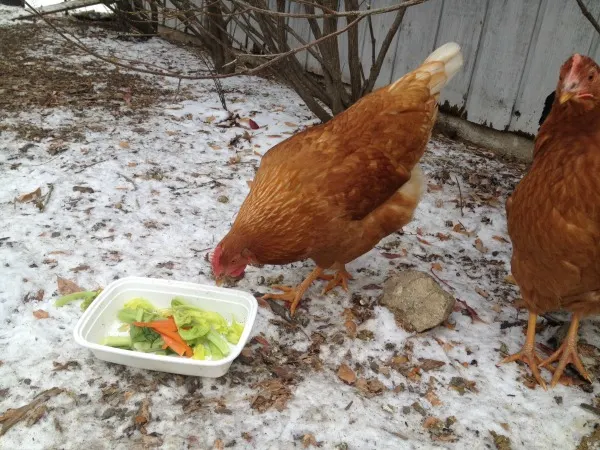
Next was a trip to the Feed Store in Summit to get chicks. I also used to buy my feed there and if you live in the city, it's a great resource. This year, though, a friend told me about Big R. I walked in there the first time and thought I'd died and had gone to heaven. I bought a 40 lb bag of scratch for $11 and a 40 lb bag of layer feed for about the same, which is substantially cheaper than the Feed Store. The scratch will last me for 3 or 4 months and the feed should last 3 months, maybe more. We feed the chickens table scraps, too -- they'll eat just about anything, and this helps supplement their diet in the winter. They do go through a lot more feed in the winter. In the summer we let them out in the yard regularly to scratch around, and they'll eat any leaves and bugs they can find.

To start with, we picked breeds of birds that were good layers -- but chose one (an Americauna), just because she'd lay cool looking eggs that are pale blue or green. The chicks grew at an amazing rate, and I quickly figured out that you have to continue to raise the feeder and waterer to above the level of their butts to prevent them from pooping in their food and water.
Chickens are messy birds
Chickens for the most part are really messy, but I've found a few ways to combat this. I found two great methods for 1) keeping the coop cleaner, and, 2) cutting the amount of maintenance they require to almost nothing.
The first trick was making a feeder that makes it so the chickens can't easily spread their food everywhere. I found this how-to video on YouTube, and it works like a champ. Basically this method keeps most of the feed in the feeder until it goes into the chickens. I'm working on a way to keep squirrels out, but I think just changing their food out has worked. I was using a mix that contained corn and something that smelled like peanuts. The squirrels thought it was yummy and ate it voraciously, so I switched to a layer feed that resembles Soylent green. The chickens love it but the squirrels don't seem interested -- I'll know for sure as the weather gets colder.
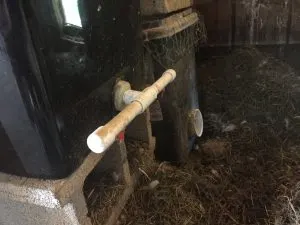
Chicken Waterer and Feeder
Then from the same guy on YouTube I found a DIY chicken waterer. For the containers I found two Kingsford charcoal containers and went at them with a jigsaw and razor knife. This works like a champ until the temperature drops below freezing, then the water freezes up. So, this past winter I bought a three gallon heated chicken waterer and think I had to refill it something like 2 or 3 times across the entire winter.
The only other item we needed to get going was a bale of straw for the flooring. While this only runs 7 or 8 bucks and lasts for 6+ months, the hardest thing was actually to find a place that carries it.
A lot of people complain (loudly) about the smell of chicken poop. Obviously these people don't have children. What my kids do is far worse then anything coming out of the chicken. The best way to combat chicken stink is with the deep litter method of keeping backyard chickens. I cover the entire floor of the coop with straw, then every week or so I throw down a little more. Whenever I do this, I also throw in some scratch (small bits of corn and seed) and the chickens will... well... scratch to get at it. In the process, they turn over the bedding on the floor of the coop. You can continue to do this for up to six months, then finally you just throw everything onto the compost heap and start over. I clean out the coop twice or three times a year, and the smell never gets too bad.
By the numbers
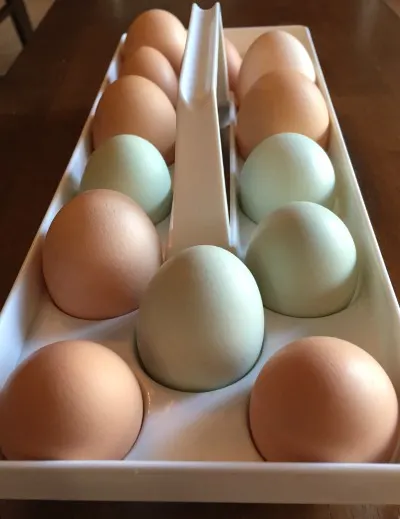
The initial cost to build the coop came in around $180 (but I started with a bunch of old lumber I already had). This was for the screws, chicken wire, poultry netting, some lumber, and of course the Sawzall rental. Chickens themselves are cheap: The chicks cost $4.50 each from the Feed Store (I recently bought two Leghorns from Big R, and they were about the same).
It took about 5 months for the chicks to grow into hens and start laying. Once they did though, we get fresh eggs almost every day. Currently we have a Rhode Island Red (named Red) that lays almost every day. My guess is that she'll lay 320 eggs this year. We also have a Golden Sex Linked named Nuggets. Recently she's been a bit off, and will only lay 3-4 days a week. Our Ameraucana is named Mabel 2, and she has been laying every day all summer. She won't keep that up in the winter, but she should come out north of 300 eggs this year. And, our two Leghorns are named Foghorn and Mrs. Cheepers. They should be strong layers too. They just hit four months old, and we got our first egg from them the other day.
Backyard chickens are farm animals, not pets

Although the chickens are friendly and enjoy being around people, they're farm animals, not family pets -- and belong outside in the "barn." We've had a couple of fatalities so far. Our original Americauna (Mabel 1) was found dead under the roost one morning. As far as we can tell she just fell over dead in the middle of the night from a heart attack or something similar. Last year, something managed to get into the coop and kill our Alpha Golden (named Fingers). There wasn't much left of her when we found her, but we're thinking skunks might have gotten her.
So I think the best approach has been to have a chicken or two more than you'll think you'll need. It seems like there is always something that chokes off production (death, molting, being stubborn, etc.). An extra bird doesn't cost that much more, and will make sure your eggs keep coming.
Sorry this has taken so long to get out there. I've been beekeeping even longer, and still haven't finished that post!

Natalie
Wednesday 14th of September 2016
Thank you for sharing!
SmartShopper
Tuesday 13th of September 2016
Wow! That is a lot of work to set up and maintain chickens. If I had a large yard and my town allowed chickens, I'd consider a coop. As much as I would LOVE to have fresh eggs every day, for now I'll stick to purchasing my eggs at the grocery store. Thanks for the post. I enjoyed reading it.
Catherine
Monday 12th of September 2016
I found this really interesting- Thanks for posting it!
Eun
Monday 12th of September 2016
"A lot of people complain (loudly) about the smell of chicken poop. Obviously these people don’t have children." lol
Thanks for sharing your story! I enjoyed reading it! I can't wait to read about your beekeeping experience.
Jen
Monday 12th of September 2016
Just wanted to say I really enjoyed the post, even if I will never in a million years have chickens in my yard, haha. :)